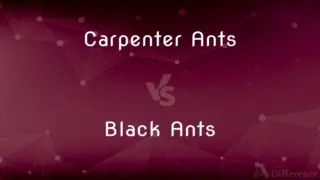Pinnate vs. Palmate — What's the Difference?
Edited by Tayyaba Rehman — By Fiza Rafique — Updated on September 22, 2023
Pinnate leaves have leaflets arranged along both sides of a central axis like a feather. Palmate leaves have lobes or leaflets radiating from a single point, resembling a hand.

Difference Between Pinnate and Palmate
Table of Contents
ADVERTISEMENT
Key Differences
Pinnate leaves are defined by having leaflets that are arranged on either side of a central axis, somewhat resembling the structure of a feather. These leaflets can either be directly opposite each other or alternate along the axis. Palmate leaves, in contrast, have leaflets or lobes that radiate from a single central point, often resembling the shape of an open hand or a star.
Pinnate leaves are often seen in plants like ferns and certain types of legumes. They are a common leaf structure in a wide range of botanical families. Palmate leaves are commonly found in plants like maples and horse chestnuts, and their design is often likened to a hand with fingers extending from a palm.
In the realm of botanical terminology, pinnate leaves can be further categorized into various types such as bipinnate, tripinnate, and even paripinnate or imparipinnate, based on the arrangement and number of leaflets. Palmate leaves can also be categorized into types like palmately lobed, palmately veined, and palmately compound, based on the intricacies of their structure.
While pinnate leaves often exhibit a more elongated and feathery appearance, palmate leaves often appear more rounded due to the radiating pattern of the leaflets. Both pinnate and palmate leaves serve specific evolutionary and ecological functions for the plants that possess them, from maximizing sunlight capture to efficient transpiration.
Comparison Chart
Arrangement
Leaflets along both sides of a central axis
Leaflets radiate from a central point
ADVERTISEMENT
Common Examples
Ferns, legumes
Maples, horse chestnuts
Appearance
Feathery
Hand-like or star-shaped
Subcategories
Bipinnate, tripinnate, paripinnate
Palmately lobed, palmately veined, palmately compound
Ecological Function
Varies, often for efficient sunlight capture
Varies, often for efficient sunlight capture
Compare with Definitions
Pinnate
Resembling a feather in arrangement.
The pinnate design can be found in some feathers as well.
Palmate
Common in maples and horse chestnuts.
You can easily identify a maple tree by its palmate leaves.
Pinnate
Often seen in legumes and ferns.
Pinnate leaves are characteristic of many legumes.
Palmate
Resembling an open hand or a star in shape.
The palmate form of the leaf resembles a hand.
Pinnate
May have directly opposite or alternating leaflets.
The pinnate leaves of this species have alternating leaflets.
Palmate
Having a shape similar to that of a hand with the fingers extended
Palmate antlers.
Palmate coral.
Pinnate
Can be bipinnate or tripinnate based on leaflet arrangement.
This plant has bipinnate leaves.
Palmate
(Botany) Having three or more veins, leaflets, or lobes radiating from one point; digitate
A palmate leaf.
Pinnate
A leaf with leaflets arranged along a central axis.
The pinnate structure of the fern leaf is fascinating.
Palmate
(Zoology) Having webbing that connects the three front toes, as the feet of many waterbirds.
Pinnate
Resembling a feather in having parts or branches arranged on each side of a common axis
Pinnate leaves.
Pinnate gills.
Palmate
Having three or more lobes or veins arising from a common point.
Although palmate leaves are typical of most Western maples, a number of species have leaves without lobes.
Pinnate
Resembling a feather.
Palmate
(botany) leaves Having more than three leaflets arising from a common point, often in the form of a fan.
Pinnate
(botany) Having two rows of branches, lobes, leaflets, or veins arranged on each side of a common axis
Mimosa is a tree with pinnate leaves.
The trunk is unbranched, often much shortened, and bears a crown of feathery or pinnate fronds.
Palmate
(rare) Having webbed appendage; palmated.
The Palmate Newt is a common Western European amphibian.
Pinnate
(zoology) Having a winglike tuft of long feathers on each side of the neck.
The pinnate grouse, or prairie chicken
Palmate
(rare) Hand-like; shaped like a hand with extended fingers
Pinnate
(zoology) Having wings or fins.
Palmate
(chemistry) A salt or ester of ricinoleic acid (formerly called palmic acid); a ricinoleate.
Pinnate
Consisting of several leaflets, or separate portions, arranged on each side of a common petiole, as the leaves of a rosebush, a hickory, or an ash. See Abruptly pinnate, and Illust., under Abruptly.
Palmate
A salt of palmic acid; a ricinoleate.
Pinnate
Having a winglike tuft of long feathers on each side of the neck.
Palmate
Having the shape of the hand; resembling a hand with the fingers spread.
Pinnate
Of a leaf shape; featherlike; having leaflets on each side of a common axis
Palmate
Spreading from the apex of a petiole, as the divisions of a leaf, or leaflets, so as to resemble the hand with outspread fingers.
Palmate
Having the anterior toes united by a web, as in most swimming birds; webbed. See Illust. (i) under Aves.
Palmate
(of the feet of water birds) having three toes connected by a thin fold of skin
Palmate
Of a leaf shape; having leaflets or lobes radiating from a common point
Palmate
A leaf with lobes radiating from a central point.
The palmate leaf of the maple tree is iconic.
Palmate
May be palmately lobed or palmately compound.
This particular species has palmately compound leaves.
Palmate
Often appears more rounded due to leaflet arrangement.
Palmate leaves usually have a rounded appearance.
Common Curiosities
What is Pinnate?
Pinnate is a type of leaf arrangement where leaflets are arranged along a central axis.
Where are Pinnate leaves commonly found?
They are common in ferns and legumes.
Where are Palmate leaves commonly found?
They are common in maples and horse chestnuts.
Can Palmate leaves be subcategorized?
Yes, they can be palmately lobed, palmately veined, etc.
How do Pinnate leaves look?
Pinnate leaves resemble feathers with leaflets along both sides of a central axis.
How do Palmate leaves look?
Palmate leaves resemble a hand or star with leaflets extending from a central point.
Are Pinnate leaves always green?
No, their color can vary depending on the plant species.
Do Pinnate and Palmate leaves serve ecological functions?
Yes, both types have specific evolutionary and ecological roles.
What is Palmate?
Palmate is a type of leaf arrangement where leaflets radiate from a single point.
Can Pinnate leaves be subcategorized?
Yes, they can be bipinnate, tripinnate, etc.
Do Palmate leaves look like hands?
Yes, they often resemble an open hand or star.
Are Pinnate leaves elongated?
They often appear more elongated and feathery.
Do Pinnate leaves have alternating leaflets?
They can have either directly opposite or alternating leaflets.
Are Palmate leaves always green?
No, their color can also vary depending on the plant species.
Are Palmate leaves rounded?
They often appear more rounded due to their leaflet arrangement.
Share Your Discovery

Previous Comparison
Ethics vs. Ethic
Next Comparison
Slat vs. LouverAuthor Spotlight
Written by
Fiza RafiqueFiza Rafique is a skilled content writer at AskDifference.com, where she meticulously refines and enhances written pieces. Drawing from her vast editorial expertise, Fiza ensures clarity, accuracy, and precision in every article. Passionate about language, she continually seeks to elevate the quality of content for readers worldwide.
Edited by
Tayyaba RehmanTayyaba Rehman is a distinguished writer, currently serving as a primary contributor to askdifference.com. As a researcher in semantics and etymology, Tayyaba's passion for the complexity of languages and their distinctions has found a perfect home on the platform. Tayyaba delves into the intricacies of language, distinguishing between commonly confused words and phrases, thereby providing clarity for readers worldwide.















































